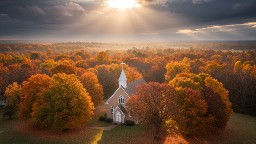-
From Death To Thanksgiving: Leading Your Church From Halloween To Hope
By Josh Read on Oct 31, 2025
As October slips into November, the signs of Halloween still hang in the air. In my neighborhood, that’s partly because my neighbor waits until Thanksgiving to take his decorations down. But even when the skeletons finally disappear, the fascination with death seems to stay. When I first served as a missionary in Africa, I saw how seriously people regarded the spiritual realm. There was no pretending about darkness or evil; it was real. That experience changed the way I see Halloween in the United States. What many treat as pretend often reveals how lightly our culture takes the battle between light and darkness. For pastors, this week holds a sacred opportunity. While the world has finished celebrating shadows, the church is called to proclaim light and life in Jesus Christ.
The Shadow Behind the Celebration
Halloween exposes something about the human heart. Beneath the costumes and carved pumpkins lies a universal curiosity with death and the supernatural. Humanity feels the pull of eternity, even when it is disguised as a night of fun. Ecclesiastes 3:11 says, “He has put eternity into the heart of man.” The world senses there is more beyond the grave, but without the gospel, that search ends in fear.
As pastors, we are called to help people see this truth clearly. Halloween does not have to be dismissed or ignored; it can be redeemed as a moment to proclaim the victory of Christ over death. Romans 6:23 reminds us that “the wages of sin is death, but the gift of God is eternal life through Christ Jesus our Lord.” The culture may flirt with darkness, but the gospel calls us to life.
The People Who Walked in Darkness
Isaiah 9:2 declares, “The people who walked in darkness have seen a great light.” This truth is as powerful today as it was in Isaiah’s time. Halloween highlights how easily people walk in darkness without realizing it. Yet God’s response to darkness is always light.
When pastors preach the Sunday after Halloween, they have a chance to redirect hearts. The message can acknowledge that while the culture celebrated death, the church celebrates resurrection. This is not a time to shame but to shepherd. Many people in our congregations took part in cultural traditions without reflection. Now is the moment to re-center the heart. God’s people are not defined by where they have been but by where His mercy is leading them.
Leaving the Graveyard Behind
Halloween may fill yards with tombstones, skeletons, and ghosts, but the resurrection reminds us that the grave is empty. The Christian life is not about managing fear; it is about walking in victory. John 1:5 says, “The light shines in the darkness, and the darkness has not overcome it.”
This Sunday can be a moment to draw a clear contrast between death and life, darkness and light, hopelessness and resurrection. Paul writes in 1 Corinthians 15:54–55, “Death has been swallowed up in victory. Where, O death, is your victory? Where, O death, is your sting?” These words are not reserved for funerals. They are declarations for the living.
If Halloween reflects the graveyard, Sunday morning should reflect the empty tomb. We are not a people who decorate death; we celebrate deliverance.
A Call to Repentance and Renewal
The first step from darkness to gratitude is repentance. Not guilt-driven remorse but a heartfelt turning toward the mercy of God. First John 1:9 promises, “If we confess our sins, He is faithful and just to forgive us our sins and to cleanse us from all unrighteousness.”
Pastors can model this by calling the church to examine where cultural conformity has dulled spiritual conviction. It is not about costumes or candy; it is about the heart. When we grow comfortable around symbols of death, we risk forgetting the price Jesus paid to defeat it.
Repentance always leads to renewal. Out of confession grows gratitude, and out of gratitude flows worship. Psalm 103 calls us to “forget not all His benefits,” reminding us that gratitude is a holy act of remembrance. As we turn from the shadow of Halloween, we step into the light of thanksgiving.
From Death to Gratitude
November opens with All Saints Day, a reminder that we belong to a great cloud of witnesses (Hebrews 12:1). What a fitting transition—from a culture obsessed with ghosts and death to a church that honors the saints and gives thanks for God’s faithfulness through generations.
Gratitude shifts our focus from fear to faith. First Thessalonians 5:16–18 exhorts, “Rejoice always, pray without ceasing, give thanks in all circumstances; for this is the will of God in Christ Jesus for you.” Thanksgiving is not seasonal for believers; it is spiritual. It turns our eyes from what frightens us to the God who sustains us.
This is the message our churches need right now. Not more debate over cultural practices, but a renewed call to gratitude—to count blessings, to recall God’s mercy, and to celebrate His grace. As the world packs away its Halloween decorations, the church should lift up a new banner: “The Lord is good, and His love endures forever.”
Practical Ways to Shepherd the Transition
-
Preach a Contrast Message
Center this Sunday’s sermon on the theme of light overcoming darkness. Draw from Ephesians 5:8, “For at one time you were darkness, but now you are light in the Lord. Walk as children of light.” Invite your congregation to step out of the graveyard and into gratitude.
-
Lead Corporate Repentance
Create space for reflection. Acknowledge the ways our culture normalizes darkness and invite people to pray for renewed hearts. Repentance opens the door for revival.
-
Launch a Gratitude Focus
Encourage thirty days of thanksgiving leading to Advent. Each day, invite members to share one specific thing God has done—publicly or in their families. Gratitude becomes contagious when spoken aloud.
-
Testify to New Life
Share stories of transformation in your congregation. Every testimony reminds believers that we serve a living Savior who still brings beauty from ashes.
-
Celebrate the Saints
This week bridges Halloween and All Saints. Honor those who have finished their race and encourage the living to run theirs with endurance. Tell stories of faith that spark worship, not fear.
The Pastor’s Role: Turning Fear into Faith
Shepherds lead through seasons of confusion. The cultural noise of Halloween gives way to the quiet gratitude of November, and pastors can help their people make that turn. The task is not to condemn but to redirect. We lead the flock from fascination with the temporary to adoration of the eternal.
In a world that laughs at death, the church proclaims life. In a culture that delights in fear, we declare peace. Romans 8:2 reminds us, “The law of the Spirit of life in Christ Jesus has set you free from the law of sin and death.”
The Season Ahead
As we enter November, gratitude prepares our hearts for Advent. The rhythm of repentance, thanksgiving, and anticipation leads us toward the coming of Christ. The same light that pierced the darkness of the grave now calls us to walk as children of the day.
Encourage your people to look forward. God’s mercy is not behind us; it is ahead. His grace meets us in every new morning. His love calls us out of shadows into His marvelous light.
Conclusion: From Shadows to Praise
I remember one Sunday in Africa when we gathered under a simple tin roof after a night of heavy storms. The power was out, but as we began to sing, the sunrise broke through the clouds and light poured into the room. It was a physical picture of a spiritual truth: darkness never wins. That morning reminded me why we preach. Pastor, this Sunday, remind your people that the world may have celebrated darkness, but we belong to the Light of the World. Let your pulpit ring with resurrection truth. Lead them from fear to faith, from death to gratitude, from shadow to praise.
Colossians 1:13–14 declares, “He has delivered us from the domain of darkness and transferred us to the kingdom of His beloved Son, in whom we have redemption, the forgiveness of sins.” That is the message for the post-Halloween church. The past is marked by death, but the future is filled with life.
In Christ, every grave is empty, every tear will be wiped away, and every heart can give thanks. The season of darkness has passed. The season of gratitude has begun.
Related Preaching Articles
-
Senior Pastor: Friend Or Foe
By Josh Griffin on Sep 14, 2024
Veteran youth director Josh Griffin gives seasoned advice to senior pastors on developing their relationship with their youth ministry leader.
-
Pornography’s Strategy Against Pastors
By Paul Kendall on Dec 15, 2022
Porn addiction destroys pastors, families, and churches. This exposes the enemy’s strategy and outlines a path to repentance, recovery, and lasting deliverance.
-
The Barnabas Factor: Five Traits That Build Leaders
By Larry Osborne on Jan 30, 2024
Barnabas quietly shaped world-changing leaders. Discover five traits that made him a master encourager and team builder, and how they can transform your ministry.
-
The 25 Most Influential Preachers Of The Past 25 Years
By Michael Duduit on Jan 2, 2025
From Billy Graham to Tim Keller, this article profiles 25 preachers who have most shaped the American pulpit over the last 25 years and why their influence endures.
-
Leadership And Church Size Dynamics
By Tim Keller on Jan 3, 2025
Tim Keller explores one of the most talked-about church issues: the relationship of size to church health and culture.
-
Five Strategic Advantages Of Small Churches
By Brandon O'brien on Feb 14, 2024
Small churches hold strategic strengths: authenticity, focus, people-powered ministry, intergenerational relationships, and margin-focused mission.
-
Preaching Real Gospel Change In A World Obsessed With Self-Improvement
By Ed Stetzer on Jan 7, 2025
True transformation is not moral effort but new life in Christ. Preachers must translate “change” into gospel terms, clarifying how God recreates, reshapes, and renews His people.
-
8 Preachable Marks Of A Transformed Life
By Philip Nation on Jan 9, 2025
Spiritual transformation is God’s work in believers, shaping them into Christ’s image. These eight biblical marks help pastors guide their people toward genuine gospel change.

 Sermon Central
Sermon Central








